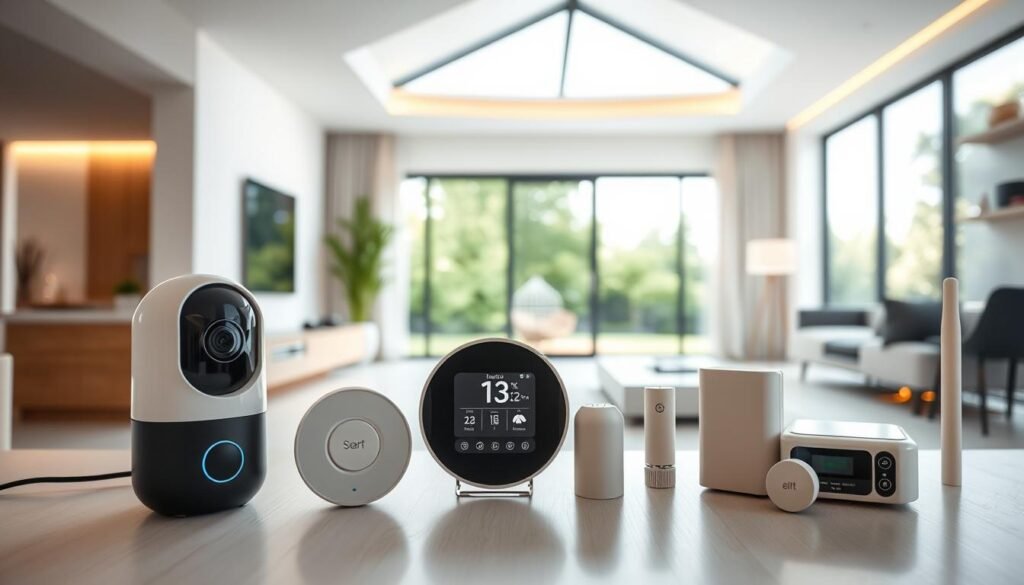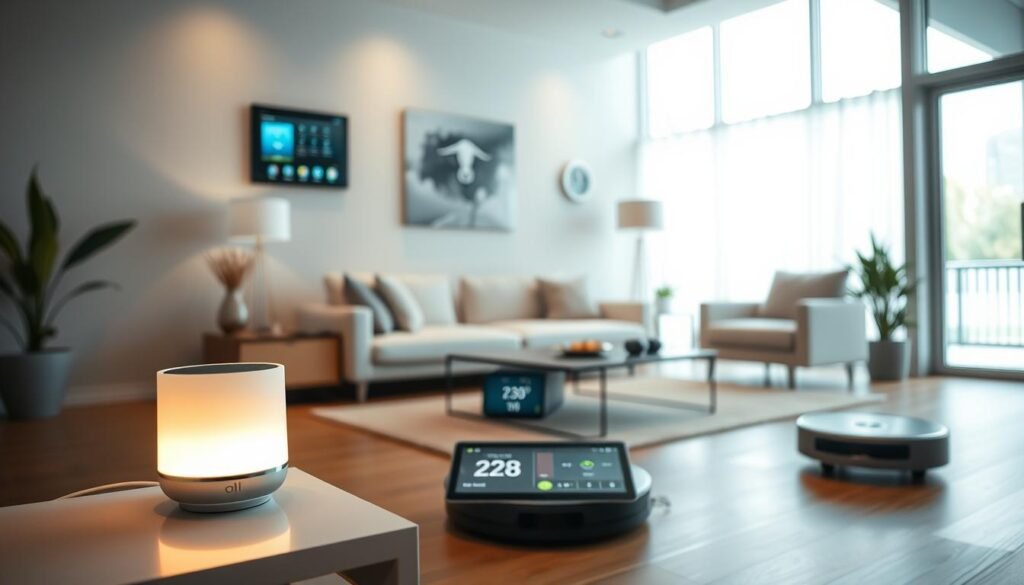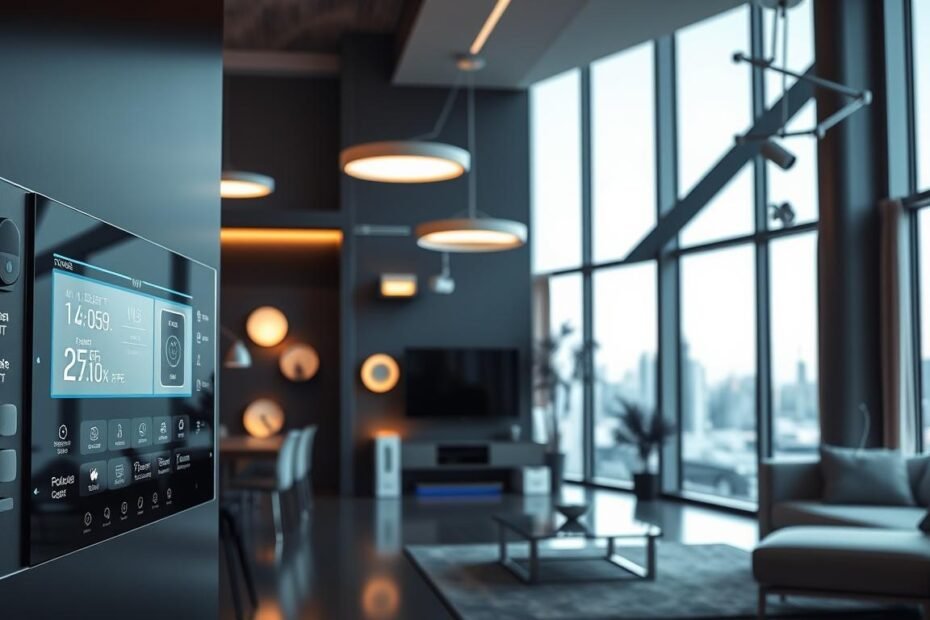Imagine waking up to a warm cup of coffee, brewed to perfection by a device that’s synced to your alarm clock. This is just one of the many conveniences offered by the latest advancements in home automation. As technology continues to evolve, integrating IoT gadgets into our daily lives has become increasingly seamless.
Upgrading your living space with the latest smart devices not only enhances your lifestyle but also makes your life more enjoyable and efficient. With the ability to control and monitor your home remotely, you’re always in command.
Key Takeaways
- Discover the top smart home devices for 2025 that will revolutionize your living space.
- Learn how home automation can simplify your daily routine.
- Explore the latest IoT gadgets that make life more convenient.
- Understand the benefits of integrating smart technology into your home.
- Find out how to control and monitor your home remotely with the latest devices.
Introduction to Smart Home Devices
Imagine a home where lighting, temperature, security, and entertainment systems are seamlessly integrated – welcome to the world of smart home systems. This is not just a futuristic concept; it’s a reality that many homeowners are embracing today.
A smart home is a residence that uses advanced technology to integrate and control various systems, such as lighting, temperature, security, and entertainment. This integration is made possible through connected home technology, which enables different devices to communicate with each other and be controlled remotely.
What is a Smart Home?
A smart home is equipped with devices and systems that can be controlled and monitored remotely using a smartphone, tablet, or computer. These devices are part of the Internet of Things (IoT), which allows them to interact with each other and their surroundings, making the home more comfortable, secure, and energy-efficient.
The core of a smart home is its ability to automate tasks. For instance, you can program your lights to turn off automatically when you leave the house or adjust the thermostat to save energy when you’re not home. This level of automation is made possible by smart home products that are designed to work together seamlessly.
Benefits of Home Automation
The benefits of home automation are numerous. One of the most significant advantages is energy efficiency. By automating lighting and heating/cooling systems, homeowners can significantly reduce their energy consumption. Additionally, smart home security systems provide enhanced safety and peace of mind.
Here is a summary of the key benefits of home automation:
| Benefit | Description |
|---|---|
| Energy Efficiency | Automated systems reduce energy consumption |
| Enhanced Security | Smart security systems provide real-time monitoring |
| Convenience | Remote control of lighting, temperature, and entertainment systems |
By embracing smart home technology, homeowners can enjoy a more comfortable, secure, and efficient living environment. Whether it’s through automating daily tasks or enhancing home security, the benefits of a smart home are undeniable.
Latest Trends in Home Automation
The world of home automation is rapidly evolving with the integration of cutting-edge technologies. As we embrace these advancements, our homes are becoming more intelligent, efficient, and convenient.
Integration of AI Technologies
The integration of AI technologies in home automation is revolutionizing the way we interact with our living spaces. Devices are now capable of learning our habits and preferences, making our lives more comfortable and enjoyable.
For instance, smart thermostats can adjust the temperature based on our daily routines, while smart lighting systems can adapt to our preferences for brightness and color.
Rise of Energy-Efficient Gadgets
Another significant trend in home automation is the rise of energy-efficient gadgets. These devices not only help reduce energy consumption but also lower utility bills.
Some examples of energy-efficient gadgets include smart power strips, energy-efficient light bulbs, and smart home energy monitors.
| Device | Energy Savings | Features |
|---|---|---|
| Smart Thermostats | Up to 20% | Temperature adjustment based on daily routines |
| Smart Lighting Systems | Up to 15% | Adaptive brightness and color |
| Smart Power Strips | Up to 10% | Automatic shutdown of idle devices |
As we continue to adopt these automated home solutions, we can expect our homes to become even more efficient and sustainable.
Must-Have Smart Home Devices for 2025
With 2025 on the horizon, it’s essential to explore the must-have smart home devices that will revolutionize the way we live. The smart home industry is rapidly evolving, with innovations that make our lives easier, more convenient, and enjoyable.
The integration of Artificial Intelligence (AI) and Internet of Things (IoT) technologies has led to the development of sophisticated smart home devices. These devices not only enhance our living experience but also provide a more secure and energy-efficient home environment.
Smart Speakers and Voice Assistants
Smart speakers and voice assistants are at the forefront of smart home technology. Devices like Amazon Echo and Google Home offer voice control, allowing users to manage their smart home devices effortlessly. These devices are equipped with advanced AI, enabling them to understand and respond to voice commands accurately.
- Control your smart home devices with voice commands
- Access a vast library of skills and apps
- Enjoy seamless integration with other smart devices
Smart Thermostats
Smart thermostats are another must-have device for 2025. Brands like Nest and Ecobee offer advanced temperature control, learning your preferences and adjusting the temperature accordingly. This not only enhances comfort but also helps reduce energy consumption.
- Automatically adjust temperature based on your schedule
- Receive energy usage reports and insights
- Integrate with other smart home devices for optimal performance
Smart Security Cameras
Smart security cameras are crucial for home security. These devices provide real-time monitoring, motion detection, and alerts to your smartphone. Brands like Ring and Arlo offer high-definition video and night vision, ensuring that your home is secure 24/7.
- Monitor your home in real-time from your smartphone
- Receive motion detection alerts and notifications
- Enjoy high-definition video and night vision capabilities
In conclusion, the must-have smart home devices for 2025 include smart speakers, thermostats, and security cameras. These devices offer advanced features, innovative functionality, and enhanced convenience, making them essential for any smart home.
The Role of IoT Gadgets in Daily Life
With the advent of IoT technology, our homes are becoming smarter, more convenient, and secure. The role of IoT gadgets in daily life is multifaceted, transforming the way we live, work, and interact with our living spaces.
Enhancing Convenience
IoT gadgets have made it possible to control various aspects of our homes remotely, enhancing convenience and making our lives easier. For instance, smart thermostats allow us to adjust the temperature of our homes from anywhere, ensuring that our living spaces are always comfortable.
Key Features of Smart Thermostats:
- Remote temperature control
- Energy usage tracking
- Automated scheduling
Similarly, smart lighting systems enable us to control the lighting in our homes with ease, using our smartphones or voice assistants. This not only enhances convenience but also helps in reducing energy consumption.
| Smart Lighting Features | Benefits |
|---|---|
| Remote Control | Convenience and Energy Savings |
| Automated Schedules | Enhanced Security and Efficiency |
Improving Home Security
IoT gadgets also play a crucial role in improving home security. Smart security cameras and doorbells with cameras allow homeowners to monitor their homes in real-time, deterring potential intruders and providing peace of mind.
“Smart security cameras have become an essential component of modern home security systems, offering advanced features such as motion detection and night vision.”

Furthermore, smart locks enable homeowners to control access to their homes, granting access to guests or service providers remotely and receiving notifications when someone enters or exits the home.
Benefits of Smart Locks:
- Keyless Entry
- Remote Access Control
- Access Notifications
In conclusion, IoT gadgets are revolutionizing the way we live, enhancing convenience, and improving home security. As connected home technology continues to evolve, we can expect even more innovative solutions to emerge, making our lives easier and more enjoyable.
Popular Brands in Smart Home Technology
The smart home technology market is dominated by a few key players that offer a range of innovative solutions. These brands have revolutionized the way we interact with our living spaces, making it easier to control and automate various aspects of our homes.
Google Nest
Google Nest is a pioneer in the smart home industry, offering a variety of devices that integrate seamlessly with other Google services. Their product line includes smart thermostats, security cameras, and doorbells, all of which can be controlled through the Google Home app. Nest devices are known for their ease of use and ability to learn a household’s temperature preferences over time.
Amazon Echo
Amazon Echo has become a household name with its range of smart speakers and voice assistants. The Echo devices allow users to control their smart home devices with voice commands, making it a central hub for intelligent home technology. Amazon’s Alexa platform supports a wide range of third-party devices, enhancing its compatibility with various smart home systems.
Apple HomeKit
Apple HomeKit is a framework that allows users to control their smart home devices using Apple devices. It provides a secure and seamless way to integrate various smart devices, ensuring that they work together cohesively. HomeKit-compatible devices are designed with security in mind, adhering to Apple’s strict privacy standards. This makes it an attractive option for those invested in the Apple ecosystem and looking for automated home solutions.
These brands are at the forefront of the smart home technology revolution, offering consumers a range of choices to suit their needs. Whether you’re looking for a comprehensive smart home system or specific devices to enhance your home’s functionality, these brands have something to offer.
Consumer Reviews and Recommendations
As we dive into the world of smart home devices, consumer reviews and recommendations play a crucial role in helping homeowners make informed decisions. With numerous options available, understanding the experiences of other users and the opinions of experts can significantly simplify the process of choosing the right devices.
Real User Experiences
Real user experiences provide firsthand insights into the performance and functionality of smart home devices. Many homeowners have shared their experiences online, highlighting the benefits and challenges they’ve encountered with various products. For instance, users of smart speakers like Amazon Echo have praised their convenience and ease of use, while some have noted issues with voice recognition accuracy.
A closer look at user reviews reveals that smart thermostats are particularly popular for their energy-saving capabilities. Devices like the Google Nest Thermostat have received high praise for their ability to learn and adapt to a household’s temperature preferences, leading to significant reductions in energy consumption.

Expert Opinions
Expert opinions offer a more in-depth analysis of smart home devices, often focusing on their technical specifications, compatibility, and overall value. Experts in the field of home automation have noted that one of the key trends in smart home technology is the integration of AI and machine learning capabilities, which enable devices to become more intuitive and responsive to user needs.
| Device | Expert Rating | User Rating |
|---|---|---|
| Amazon Echo | 4.5/5 | 4.2/5 |
| Google Nest Thermostat | 4.7/5 | 4.5/5 |
| Apple HomeKit | 4.3/5 | 4.1/5 |
In conclusion, both real user experiences and expert opinions are invaluable resources for anyone looking to invest in smart home devices. By considering these perspectives, homeowners can make more informed decisions and create a more efficient, convenient, and enjoyable living environment.
Setting Up Your Smart Home Ecosystem
The key to a seamless smart home experience lies in choosing the right devices and ensuring they work together harmoniously. As you embark on setting up your connected home technology, it’s essential to consider a few critical factors.
Choosing the Right Devices
With the vast array of smart home products available, selecting the right devices can be overwhelming, but it’s a crucial step. Start by identifying your needs: Do you want to enhance home security, improve energy efficiency, or simply add convenience to your daily routine?
- Consider devices that are compatible with your existing ecosystem.
- Look for products with good user reviews and reliable customer support.
- Think about the scalability of your system to accommodate future additions.
Popular brands like Google Nest, Amazon Echo, and Apple HomeKit offer a range of IoT gadgets that can be integrated into your smart home system. For instance, smart speakers with voice assistants can control multiple devices, making it easier to manage your smart home.
Ensuring Compatibility between Gadgets
Ensuring compatibility between gadgets is vital for a cohesive smart home experience. Different devices use various protocols such as Zigbee, Z-Wave, or Bluetooth. It’s crucial to choose devices that are compatible with your hub or central control device.
| Protocol | Devices | Advantages |
|---|---|---|
| Zigbee | Light bulbs, sensors | Low power consumption, mesh network capability |
| Z-Wave | Thermostats, security devices | Reliable, easy to install |
| Bluetooth | Speakers, headphones | Wide compatibility, easy to set up |
By carefully selecting devices and ensuring they are compatible, you can create a connected home technology ecosystem that enhances your living experience. Remember, the goal is to make your life easier and more enjoyable with the right smart home products.
Future of Smart Home Devices
The future of smart home devices is exciting, with technological advancements expected to revolutionize the industry. As we move towards 2025, intelligent home technology is becoming increasingly integrated into our daily lives, making our homes more comfortable, secure, and energy-efficient.
Advancements in Automation
Upcoming innovations in automated home solutions will continue to shape the industry. AI-powered devices, for instance, will enable more seamless interactions between different smart technology devices, creating a more streamlined and intuitive user experience.
5G and Home Automation
The impact of 5G on home automation will be significant, enabling faster data transfer rates and more reliable connections between devices. This will allow for more complex and sophisticated smart home systems, further enhancing the convenience and security offered by these systems.
To stay updated on the future of smart home devices, it’s essential to keep an eye on emerging trends and technologies. As intelligent home technology continues to evolve, we can expect to see even more innovative solutions that make our lives easier and more enjoyable.
FAQ
What is a smart home and how does it work?
A smart home is a residence that uses advanced technology to integrate and automate various systems, such as lighting, temperature, security, and entertainment. It works by connecting devices and systems through a central hub or network, allowing for remote control and monitoring through smartphones, tablets, or voice assistants.
What are the benefits of home automation?
The benefits of home automation include increased energy efficiency, improved safety, and enhanced convenience. With smart home devices, homeowners can automate and control various aspects of their homes, making their lives easier and more enjoyable.
What are the must-have smart home devices for 2025?
Some of the must-have smart home devices for 2025 include smart speakers, such as Amazon Echo and Google Home, smart thermostats, such as Nest and Ecobee, and smart security cameras, such as those offered by Ring and Arlo. These devices offer advanced features and innovative functionality, making our lives easier and more enjoyable.
How do IoT gadgets enhance convenience and improve home security?
IoT gadgets, such as smart security cameras and doorbells, offer advanced security features, while smart home automation systems enable homeowners to control their homes with ease. With the help of IoT gadgets, homeowners can control and monitor their homes remotely, making their lives easier and more enjoyable.
What are some popular brands in smart home technology?
Some popular brands in smart home technology include Google Nest, Amazon Echo, and Apple HomeKit. These brands offer a range of smart home devices and systems, making it easy for homeowners to find the right solution for their needs.
How do I choose the right smart home devices for my needs?
To choose the right smart home devices, consider your specific needs and preferences. Research different devices and brands, and read consumer reviews and expert opinions to make informed decisions. Ensure compatibility between gadgets and consider factors such as ease of use, functionality, and price.
What is the impact of 5G on home automation?
The impact of 5G on home automation is significant, as it enables faster and more reliable connectivity between devices. With 5G, smart home devices will become even more connected and integrated, making our lives easier and more enjoyable.
What are some upcoming innovations in smart home technology?
Some upcoming innovations in smart home technology include AI-powered devices and smart home automation. These innovations will continue to shape the industry, making our lives easier and more enjoyable.
How do I ensure compatibility between smart home devices?
To ensure compatibility between smart home devices, choose devices that use the same protocol or standard, such as Zigbee or Z-Wave. Also, consider devices that are compatible with popular smart home systems, such as Amazon Alexa or Google Home.
